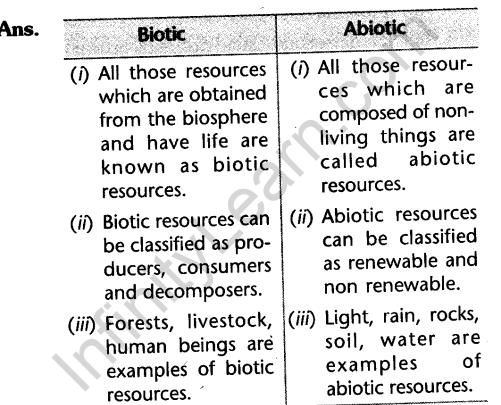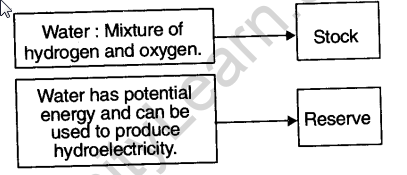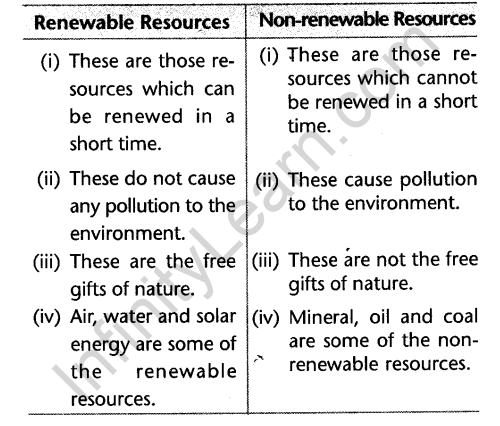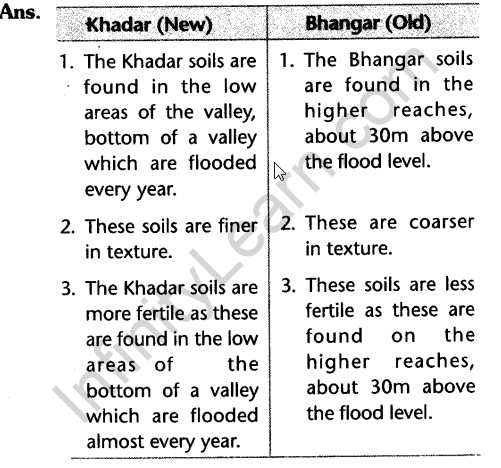CBSE Class 10 Geography Resource and Development LAQ
Q. 1. What is resource planning ? Mention the steps which are involved in resource planning. [CBSE 2009 (F); Sept. 2010, 14]
Or
Explain the three steps involved in the resource planning in India. [CBSE Sept. 20W]
Or
What are the three stages of resource planning in India?
Ans. “Resource planning is a technique or skill of proper or judicious use of resources. ”
Resource planning is a complex process which involves :
(i) Identification and inventory of resources across the regions of the country. This involves surveying, mapping, qualitative and quantitative estimation and measurement of the resources.
(ii) Evolving a planning structure endowed with appropriate technology, skill and institutional set up for implementing resource development plans.
(iii) Matching the resource development plans with overall national development plans.
Q. 2. Explain the classification of resources on the basis of exhaustibility. [CBSE 2009 (D), Sept. 2010, 2011]
Ans. (i) Renewable resources: “Renewable resources are the natural resources which can be used again and again or can be reproduced by physical, mechanical and chemical processes.” Solar energy, air, water and soil are some of the renewable resources of energy.
(ii) Non-renewable resources: “Non renewable resources are the natural resources that cannot be replaced at all or within a reasonable time.” Fossil fuels such as oil, gas and coal are examples of non renewable resources. These resources are accumulated over millions of years. They are considered to be non-renewable resources because once they are used up, they are gone forever.
Q. 3. Explain the classification of resources on the basis of origin.
Or
Give two examples of abiotic resources. [CBSE 2010(F)]
Or
What are biotic and abiotic resources ? Give two examples for each. [CBSE Sept. 2010]

Q- 4. Explain the classification of resources on the basis of ownership. [CBSE 2009 (O), 2014]
Or
Explain what is meant by national resources and individual resources. [CBSE Sept. 2010, 2014]
Ans. (a) Individual Resources: Resources which are owned by private individuals are known as individual resources. Plots, fields, houses, cars, books, etc., are some examples of individual resources.
(b)Community Owned Resources : The resources which are accessible .to all the members of the community are known as community resources. Village ponds, public parks, playgrounds, etc., are some examples of community resources.
(c)National Resources: All the resources which are under the control of state or union government are known as national resources. All the resources within political boundaries are national resources because the government has the power to acquire even the private properties
(d)International Resources: These resources are owned and regulated by international institutions. The oceanic resources beyond 200 km of the Exclusive Economic Zone belong to the open ocean, and no individual country can utilise these without the concurrence of international institutions. India has got the right to mine manganese nodules from the bed of the Indian Ocean from that area which lies beyond the Exclusive Economic Zone.
Q.5.Explain the classification of resources on the basis of the state of development. [CBSE 2008]
Or
Distinguish between stock resources and reserve resources. [CBSE Sept. 2010,12]
Ans. (i) Potential Resources : Resources which are found in a region, but have not been utilised due to lack of capital or other reasons. For example: the western parts of India, particularly Rajasthan and Gujarat have enormous potential for the development of wind and solar energy, but so far, these have not been developed properly.
(ii) Developed Resources : These are resources which have been surveyed and their quality and quantity have been determined for utilisation. The development of resources depends on technology and the level of their feasibility. For example, India has a cumulative total of about 2,47,847 million tonnes of coal resources.

(iii) Stock : These are the materials in the environment which have the potential to satisfy the human needs but cannot be
used as the human beings do not have the appropriate technology to convert them into usable form. For example, water (H20) is a compound of two inflammable gases, i.e., hydrogen and oxygen, but human beings do not have the required technology to use them as a source of energy.
(iv) Reserves : These are the subset of the stock, which can be put into use with the existing technology, but their uses have been postponed keeping in mind the needs of the future generations. For example, India has sufficient amount of forests to fulfil the needs of the present generation, but they are being protected for the future generations.
Q. 6. Distinguish between Renewable and Non renewable resources. [CBSE Sept. 2010]

Q.7. HOW is land a natural resource of utmost importance ? Explain with four facts. [CBSE 2008 (O), 2012, 2013]
Or
“Land is a natural resource of utmost importance.” Elaborate the statement with the help of suitable examples highlighting the value of land resource. [CBSE 2013]
Ans. Land is an important natural resource, because :
(i)All economic activities are performed on land.
(ii)It supports natural vegetation and wildlife.
(iii)Most of the minerals are formed in land.
(iv)It is used for transport and communication system.
Q-8. Which is the most widely spread and important soil of India ? State any six characteristics of this type of soil. [CBSE 2008 (F), Sept. 2010]
Or
Mention any four characteristics of alluvial soils.
Or
How are alluvial soils formed ? How is Bangar different from Khadar ? [CBSE 2012]
Ans. Alluvial soil
Characteristics of the Alluvial soil :
(i) Alluvial soils are transported soils. Most of the soils are derived from the sediments deposited by rivers as in the Indo-Gangetic plain. Thus, the parent material of these soils is of transported origin.
(ii) These soils consist of varying proportion of sand, silt and clay. In the upper course of the river, the soil is coarse. In the middle course, it is medium, and fine grained in the lower course.
(iii) Apart from the size of their grains or particles, soils are described according to their age as well. They are old alluvium and new alluvium. Locally, the old alluvium is called ‘Bhangar’ and the new alluvium is called ‘Khadar’.
(iv) The old alluvium often contains ‘kankar, nodules, with calcium carbonates in the sub-soil. The new alluvium is more fertile than the old alluvium.
Q.9. Distinguish between Khadar and Bhangar.[CBSE 2010(0), Sept. 2010, 2011]

Q.10. Which soil is called ‘regur soil’ ? Mention
any four characteristics of this type of soil. [CBSE 2009 (F), Sept. 2010, 2012, 2013]
Ans. Black soil
(i) These have been formed due to withering of lava.
(if) The black soils are made of extremely fine materials, i.e., clayey materials.
(iii)These soils are rich in soil nutrients such as calcium carbonate, magnesium carbonate, potash and lime.
(iv)These soils are generally poor in phosphoric content.
(v)The soil is well known for its capacity to hold moisture.
Q.11. How is red soil formed ? Mention its three characteristics. [CBSE Sept. 2010]
Or
How does red soil develop ? What makes it look red and yellow ? [CBSE 2014]
Ans. Formation : Most of the red soils have come into existence due to weathering of ancient crystalline igneous rocks. Characteristics/Features :
(i) Soils are loamy in deep depressions and in uplands. They consist of loose gravels and highly coarse materials.
(ii)The colour of these soils is generally red, often grading into brown, chocolate or yellow. The red colour is due to wide diffusion rather than high percentage of iron content. It looks yellow when it occurs in a hydrated form.
(iii)Soils are deficient in phosphoric acid, organic matter and nitrogenous materials but are fairly rich in potash. But crops are cultivated with the use of fertilizers.
Q.12. Which geographical factors are responsible for the evolution of black soil ? Why is it considered the most suitable for growing cotton ? [CBSE 2012, 2013]
Ans. (1) Climatic conditions like temperature, rainfall etc. along with present rock material are important factors for making of black soil. The parent rock is volcanic rock.
(2) It is ideal for growing cotton because:
(i)It has capacity to hold moisture.
(ii)They are rich in calcium carbonate, magnesium, potash and lime.
(iii)This soil is also known as black cotton soil,
(iv) They develop deep cracks during hot weather, which help in the proper
aeration of the soil.
Q.13. How is mountain soil (forest soil) formed ? Mention any four characteristics of forest soil. .
Ans. Formation: The soils are formed due to mechanical weathering caused by snow, rain, temperature variation, etc. Characteristics/Features :
(i) These soils are heterogeneous in nature, and their character changes with mountainous environment and altitude.
(ii) The soils are very rich in humus, but are deficient in potash, phosphorus and lime.
(iii) The soils are especially suitable for plantation of tea, coffee, spices and tropical fruits.
(iv) The soil is loamy and silty in valley sides and coarse grained in the upper slopes. It is acidic with low humus content in the snow covered areas. It is fertile in the lower parts of the valleys.
Q.14. Mention any four features of the arid soils.
Or
Name the soil type which is widely found in Western Rajasthan. Explain two important characteristics of this soil type which make it unsuitable for cultivation. [CBSE 2012]
Ans. Arid soil is widely found in Western Rajasthan.
(i) The soil ranges red to brown in colour.
(ii) The soils contain considerable amount of soluble salts.
(iii) The soils contain a low percentage of organic matter due to dry climate and absence of vegetation.
(iv) The soil is alkaline in nature as there is no rainfall to wash soluble salts.
(v) The lower horizon of the soil is occupied by ‘kankar’ because of the increasing calcium content downwards. The ‘kankar’ layer formations in the bottom horizons restrict the infiltration of water.
(vi) The soils are infertile but with irrigation and
fertilizers, the drought resistant and salt tolerant dry crops such as barley, cotton, wheat, millets, maize, pulses, etc., are grown. (Any Four)
Q.15. Explain the formation and important features of the laterite soil. [CBSE 2013, 14]
Ans. Formation : It develops in areas with high temperature and heavy rainfall. The laterite soil is a result of intense leaching owing to heavy tropical rains.
Features :
(i) The soils are acidic in nature, coarser and crumbly in texture.
(ii) Due to lack of nitrogen, potassium and organic elements, the laterite soils lack fertility, and are not suitable for cultivation. But when the soils are manured and irrigated, some crops can be cultivated.
(iii) As the soils are indefinitely durable, so they provide valuable building materials.
Q.16. What is soil erosion ? Explain the major types of soil erosions prevailing in India. [CBSE Sept. 2010]
Ans. “Soil erosion is the removal of soil by the forces of nature like wind and water, more rapidly than the various soil forming processes can replace it.” Generally, there is a balance between the soil forming process and the erosional process. The balance can be disturbed by natural or human factors.
Types of Soil Erosion :
(a) Water Erosion : Water is a powerful agent of soil erosion. Following are the major types of erosion caused by water.
(i) Sheet Erosion : When the top layer of the soil is removed over a large area by the running water, it is called as sheet erosion.
(ii) Rill Erosion : This is the second stage of sheet erosion. If erosion continues unchecked for a sufficient time, (rills) or small finger-shaped grooves which are a few centimetres in depth, may develop on the landscape. Over a period of time, the fine rills increase in number and also become deeper and wider, and resemble the twigs, branches and trunk of a tree. This is called as rill erosion.
(iii) Gully Erosion : This is the third stage of sheet erosion. With further erosion of the soil, the rills may deepen and become enlarged, and are ultimately turned into gullies. The main cause of gully erosion is the removal of vegetation, particularly of trees with their widespread binding roots. Gullies cut up agricultural land and the entire area may be turned into a bad land
topography. Gully erosion is also responsible for the formation of ravines.
(b) Wind erosion : Wind is a powerful agent of erosion in arid and semi-arid lands with little rainfall. Wind can lift the valuable top soil from one area and deposits in another area. The wind erosion is very dangerous type of erosion because due to wind most of the deserts of the world are expanding.
Q.17. With reference to the types of soil, answer the following questions :
(i) Name any four regions or states where alluvial soil is formed. [CBSE Sept. 2010]
(ii) Name any four regions or states where red and yellow soils are formed.
(iii) Name any four regions or states where laterite soil is formed.
Ans. (i) Rajasthan, Gujarat, deltas of Mahanadi and Godavari, and deltas of Krishna and Kaveri rivers.
(ii) Odisha, Chhattisgarh, Southern parts of the middle Ganga plain and the Western Ghats.
(iii) Karnataka, Kerala, Tamil Nadu and Madhya Pradesh.
Q-18. State two main differences between the Alluvial soil and the Red soil.

Q.19. Give reasons :
(i) Alluvial soil can hold moisture, and is very fertile.
(ii) Black soil needs to be tilled after the first rain.
(iii) Red soil is ideal for dry farming.
(iv) The percentage of organic matter in desert soil is very low.
(v) Red soil is less fertile.
Ans. (i) Because the alluvial soil is made up of fine particles. The soil is very fertile because it is rich in mineral nutrients like potash and lime.
(ii) The soil is sticky, and difficult to work unless tilled immediately after the first rain.
(iii) Because it does not require much moisture.
(iv) Because of the dry climate and absence of vegetation.
(v) Because it is deficient in phosphorus, nitrogen, lime and humus.
Q.20. Name two important crops associated with the following types of soil :
(a) Alluvial soil (b) Black soil
(c) Desert soil (d) Laterite soil
Ans. (a) Alluvial: Wheat and rice.
(b) Black: Cotton and sugarcane.
.(c) Desert: Barley and ragi.
(d) Laterite: Coffee and tea.
Q.21. Explain the land-use pattern of India.
Ans. (i) The net sown area in India has decreased from 45.26% to 43.41%. This means that more and more agricultural land is being shifted to other activities. This is not a healthy trend, and must be checked. The steps taken by government has resulted in increase of net sown area to 47% in 2005-06.
(ii) The pattern of the net sown area varies greatly from one state to another. It is over 80 per cent of the total area in Punjab and Haryana, and less than 10 per cent in Arunachal Pradesh, Mizoram, Manipur and the Andaman and Nicobar Islands.
(iii) The area under forests has increased from 18.11% in 1960-61 to 22.57% in 2000-03 and to 23% in 2005-06 yet it is far below than the scientific norms.
(iv) The land under permanent pasture is very low, i.e., only 3.45% (Fallen to 3%). This shows the tremendous pressure of livestock population on agricultural land. Cattle are reared mainly on the farm wastes, grain chaff and a few fodder crops.
(v) Area under fallow land has also decreased which shows, that subsistence agriculture is being replaced by commercial agriculture.
(vi) A part of the land is termed as waste land, and land put to other non-agricultural uses. Waste land includes rocky, arid and desert areas, and land put to other non- agricultural uses includes settlements, roads, railways, industries, etc.
Q. 22. Explain any four proper fanning techniques which can be used for soil conservation.
Or
Suggest any three measures of soil conservation. [CBSE Sept. 2010, 2011]
Or
What is soil conservation ? Explain any three methods of soil conservation suitable to Indian conditions. [CBSE 2013, 14]
Ans. Soil conservation includes all those measures which help in protecting the soil from erosion or degradation.
(i) Crop rotation : If the same crop is sown in the same field, year after year, this consumes certain nutrients from the soil making it infertile. Crop rotation can check this type of erosion.
(ii) Settled agriculture : Checking and reducing shifting agriculture by persuading the tribal people to switch over to settled agriculture.
(iii) Terracing and contour bunding :
Terracing and contour bunding across the hill slopes is a very effective, and one of the oldest methods of soil conservation. Hill slope is cut into a number of terraces having horizontal top and steep slopes on the back and front. Contour bunding involves the construction of bank along the contour.
(iv) Strip cropping : Large fields can be divided into strips. Strips of grass are left to grow between the crops. This breaks up the force of the wind. This method is known as strip cropping.
(v) Shelter Belt : Planting lines of trees to create shelter also works in a similar way. Rows of such trees are called shelter belts. These shelter belts have contributed significantly to the stabilisation of sand dunes and in establishing the desert in western India.





